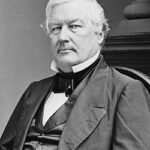President Millard Fillmore made one of America’s most controversial foreign policy decisions in 1852. He authorized Commodore Matthew Perry to force Japan’s doors open to Western trade. This decision sparked intense debate about American imperialism and gunboat diplomacy.
The Decision Behind Perry’s Mission
Fillmore faced mounting pressure from American merchants and whaling companies. They demanded access to Japanese ports for supplies and trade opportunities. Japan had maintained strict isolation for over 200 years under the Tokugawa shogunate. The president chose military intimidation over diplomatic patience. 💰 Economic interests drove this controversial choice more than humanitarian concerns.
Gunboat Diplomacy in Action
Perry received orders to use overwhelming naval force if necessary. Four warships would demonstrate American military superiority to Japanese officials. This approach violated traditional diplomatic protocols and international law principles. Critics immediately condemned the mission as cultural imperialism disguised as commerce. ⚠️ The decision reflected growing American confidence in Manifest Destiny’s global application.
International Reactions
European powers watched America’s aggressive tactics with mixed reactions. Some praised American boldness in opening Asian markets. Others worried about precedents for forcing sovereign nations into unwanted agreements. 📊 The Commodore Perry opening Japan controversy highlighted America’s transformation from isolationist republic to imperial power.
Impact:
Perry’s successful mission fundamentally altered both Japanese society and America’s international reputation. The consequences extended far beyond simple trade agreements between two nations.
Japan’s Forced Transformation
The Convention of Kanagawa in 1854 shattered Japan’s centuries-old isolation policy. Japanese society faced unprecedented foreign influence and internal upheaval. Traditional power structures began crumbling under Western pressure and modernization demands. 🔥 The Meiji Restoration of 1868 directly resulted from this forced opening. Japan’s rapid militarization and industrialization followed Western models imposed through Perry’s mission.
American Imperial Precedent
Fillmore’s decision established dangerous precedents for American foreign policy in Asia. Future administrations used similar gunboat diplomacy tactics throughout the Pacific region. The Philippines, Hawaii, and other territories fell under American influence through comparable methods. 🌍 This marked America’s transition from continental expansion to overseas imperialism. Critics argued the Commodore Perry opening Japan violated American founding principles of self-determination.
Long-term Global Consequences
Japan’s forced modernization created a formidable military rival within decades. The same Western technology imposed by Perry enabled Japan’s later imperial expansion. World War II’s Pacific theater traced its origins to this 1850s confrontation. 📉 Traditional Japanese culture suffered irreversible damage from sudden Western influence. The decision’s legacy continues influencing US-Japan relations and Asian geopolitics today.
